The ASRock DeskMini A300 Review: An Affordable DIY AMD Ryzen mini-PC
by Ganesh T S on April 26, 2019 8:00 AM ESTBAPCo SYSmark 2018
The ASRock DeskMini A300 was evaluated using our Fall 2018 test suite for small-form factor PCs. In the first section, we will be looking at SYSmark 2018.
Prior to describing the benchmark itself, we should quickly address concerns about using the benchmark to test AMD-based systems, given that AMD is not a part of the BAPCo consortium. In fact, AMD has been pretty vocal against the benchmark, with their last salvo appearing in 2016. AMD had quit BAPCo in 2011 over concerns of the GPU not being represented enough in the benchmarks.
Having analyzed the SYSmark 2018 white paper, and actually followed the execution of the benchmark workloads, we can say that SYSmark 2018 does represent possible usage patterns for a PC used in a business / office setting. Even if one were to side with AMD on the scoring aspect, the benchmark's rather unique energy consumption metric accurately represents the efficiency of the system for the realistic workloads. Overall, we believe that SYSmark 2018 is a good benchmark for systems used in certain scenarios; though it goes without saying that we never put too much stock in any one benchmark, which is why we only use it as one of out several benchmarks in our mini-PC reviews.
Anyhow, BAPCo's SYSmark 2018 is an application-based benchmark that uses real-world applications to replay usage patterns of business users in the areas of productivity, creativity, and responsiveness. The 'Productivity Scenario' covers office-centric activities including word processing, spreadsheet usage, financial analysis, software development, application installation, file compression, and e-mail management. The 'Creativity Scenario' represents media-centric activities such as digital photo processing, AI and ML for face recognition in photos and videos for the purpose of content creation, etc. The 'Responsiveness Scenario' evaluates the ability of the system to react in a quick manner to user inputs in areas such as application and file launches, web browsing, and multi-tasking.
Scores are meant to be compared against a reference desktop (the SYSmark 2018 calibration system, a Dell Optiplex 5050 tower with a Core i3-7100 and 4GB of DDR4-2133 memory to go with a 128GB M.2 SATA III SSD). The calibration system scores 1000 in each of the scenarios. A score of, say, 2000, would imply that the system under test is twice as fast as the reference system.
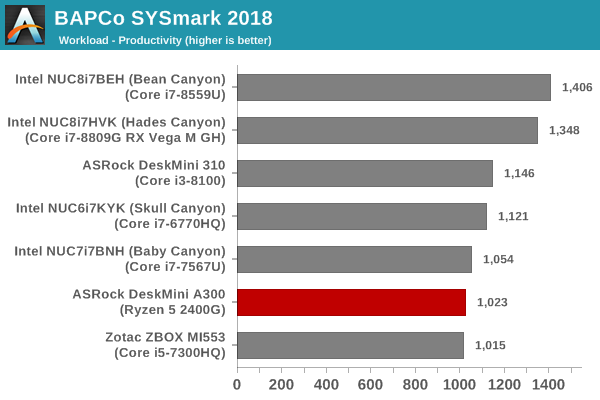
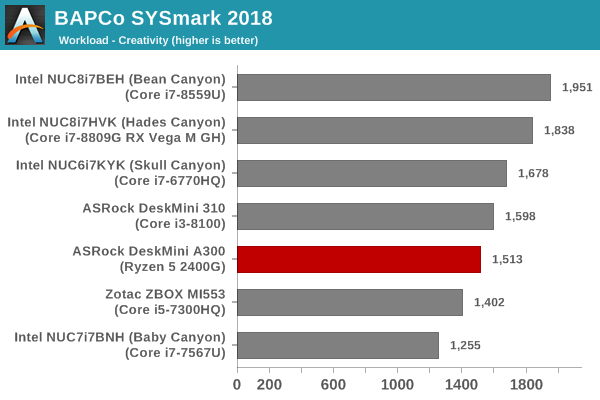
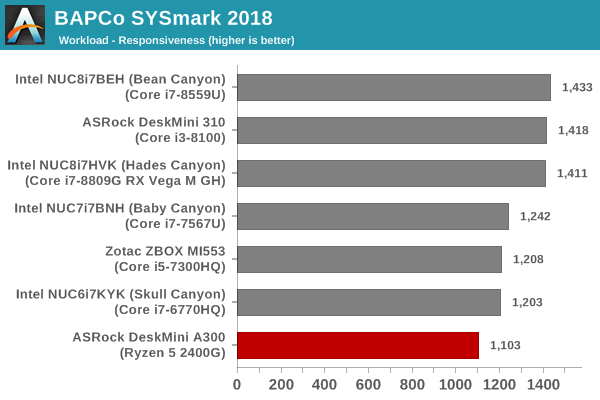
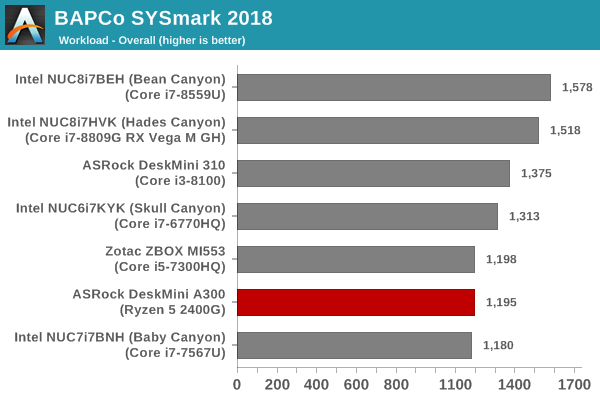
SYSmark 2018 also adds energy measurement to the mix. A high score in the SYSmark benchmarks might be nice to have, but, potential customers also need to determine the balance between power consumption and the efficiency of the system. For example, in the average office scenario, it might not be worth purchasing a noisy and power-hungry PC just because it ends up with a 2000 score in the SYSmark 2014 SE benchmarks. In order to provide a balanced perspective, SYSmark 2018 also allows vendors and decision makers to track the energy consumption during each workload. In the graphs below, we find the total energy consumed by the PC under test for a single iteration of each SYSmark 2018 workload. For reference, the calibration system consumes 5.36 Wh for productivity, 7.71 Wh for creativity, 5.61 Wh for responsiveness, and 18.68 Wh overall.
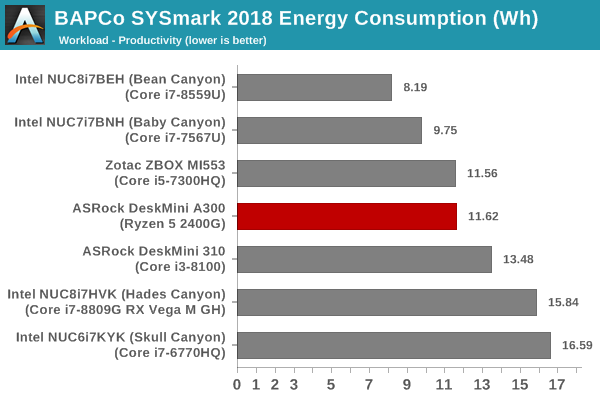


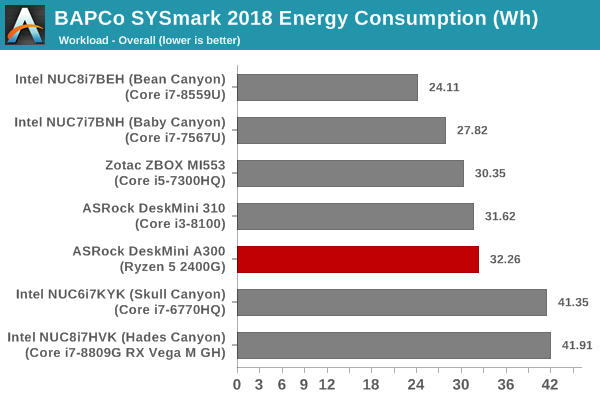
In the rest of the review, our focus will be on comparing the performance of the DeskMini A300 with the Ryzen 5 2400G and the DeskMini 310 with the Core i3-8100. Our builds for the system have approximately the same price point, and they are both contemporary systems. The overall energy consumption for the A300 is only slightly higher than the DeskMini 310, but the benchmark scores are lower. The DeskMini A300 configuration performs as well as the Zotac ZBOX MI553 (with the 45W Core i5-7300HQ) and the Baby Canyon NUC (with the 15W Core i7-7567U). However, those machines consume around 2 to 5 Wh less to achieve those scores.










88 Comments
View All Comments
abufrejoval - Friday, April 26, 2019 - link
Or an M.2 slot? They seem to have forgotten that slots were for extensibility and I would very much like the ability to upgrade to an NBase-T via an M.2 card (unless included)... They have lots of creative solutions for servers...Unfortunately I see only confusion ahead: With USB4 and x0-Gbit Ethernet, bandwidth won't be an issue, but latency, interoperability and turf wars might last forever.
mooninite - Friday, April 26, 2019 - link
Finally! A Ryzen + Vega mini PC! It blows a more expensive, Intel Iris NUC out of the water. Amazing!PeachNCream - Friday, April 26, 2019 - link
It does so it's a nice option for iGPU gaming. However Bean Canyon and other Iris parts are at a notable TDP disadvantage. I doubt the extra headroom would make up much of the difference, but if the Iris parts had additional power and cooling to put them on an even footing, I don't believe the advantage would be as significant. Despite that, I do like Ryzen and think its a worthwhile trade-off to make for a gaming use case.abufrejoval - Friday, April 26, 2019 - link
So I thought, too. But then I looked at the power figures idle and max at the wall plug: Much less actual difference than 15/65 Watt would make you believe.Alexvrb - Saturday, April 27, 2019 - link
Plus the 3200G/3400G may drop TDP further. Although, can't you cTDP the 2x00G models to 45W already?mikato - Tuesday, April 30, 2019 - link
I like your thinking, but will it take them almost a year to get out a mini PC for those once they are released? Ugh.Alexvrb - Tuesday, April 30, 2019 - link
It's an AM4 barebones. The 3000 CPUs are Zen 2, but the 3200G/3400G APUs are just tweaked Zen+ based models, 12nm but (similar to RX 590) probably not a true dieshrink. I'm not even sure if you'd need a newer-than-current BIOS update for them to boot (though it would be recommended regardless). At any rate that's all that you might need, a BIOS update.mikato - Tuesday, April 30, 2019 - link
Yeah I agree - idle power usage of 11.24 watts for this DeckMini A300 vs the 8.45 watts of the NUC8i7BEH with Bean Canyon. That's a difference of only 2.8 watts!Irata - Wednesday, May 1, 2019 - link
And this difference may very well be due to other factors like PSU, memory, mainboard....eastcoast_pete - Friday, April 26, 2019 - link
Question/Showing my ignorance of the capabilities of the chipset here: so, with this setup, is it possible to fine-tune the 2400G's CPU and GPU (undervolting, adjusting the frequency)? It sounds as if none of that would be possible, but again, I have no experience with this chipset and MoBo.